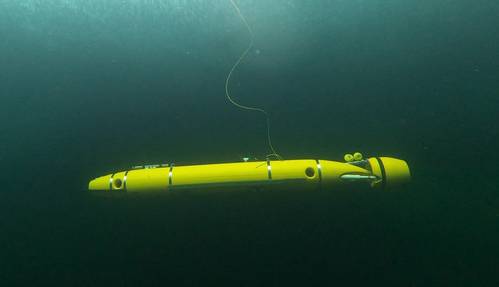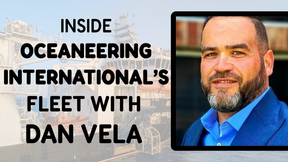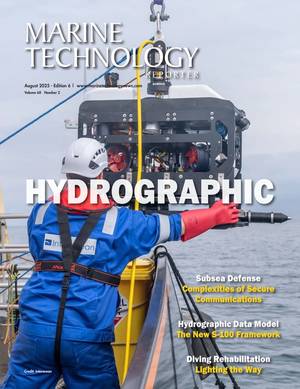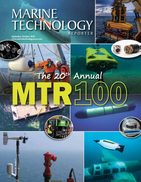Strong Winds, Calm Seas

Underwater view of the AUV DeepLeng diving in the frozen lake Torneträsk during the Abisko field trials of the project EurEx-LUNa. © DFKI
In the race for renewables, scientists and researchers must keep operations as sustainable as the energy itself. Offshore wind is no exception; as the industry sees increasing demand and quick growth, establishing environmentally responsible operations and monitoring early on are key for long-lasting systems that are not destructive to local biodiversity.
The SeaMe project (Sustainable Ecosystem Approach in Monitoring the Marine Environment), set to run from 2024 to 2026 at an RWE AG wind farm in Kaskasi, Germany, is trying to do just that. With innovative technologies like autonomous underwater vehicles (AUVs), researchers can conduct comprehensive ecosystem monitoring that is less costly, invasive and CO2-intensive. Findings will highlight the overlap between offshore wind farms and the local ecosystem by collecting physical and biological data. Parameters like temperature, salinity and oxygen may identify changes in the distribution and abundance of species, stated a press release from RWE. This includes critical contributors like phyto and zooplankton, which play fundamental roles in the food chain but are often overlooked.
The demands of the SeaMe project require multiple partners with varied expertise, each covering a special task within the wind farm’s ecosystem, explained Marius Wirtz, Dipl.-Ing. (FH), Engineer at the German Research Center for Artificial Intelligence (DFKI) and project leader of the AUV team. In addition to DFKI, collaborators include the Alfred Wegener Institute Helmholtz Centre for Polar and Marine Research (AWI), Helmholtz Institute for Functional Marine Biodiversity at the University of Oldenburg (HIFMB), BioConsult SH, the Danish company DHI A/S and the Norwegian company Spoor AS.
Ecosystem Examination
The AUV team from DFKI will monitor the underwater ecosystem. “The goal is to replace invasive sampling methods such as fishing with trawler nets, reduce CO2 emissions and help to generate a more complete view of the ecosystem. Our underwater robot, DeepLeng, aims to detect fish and sea mammals using computer vision and cutting-edge machine learning technologies.” Plus, the vehicle will record oceanographic parameters such as temperature, salinity, chlorophyl-a and turbidity, creating a holistic understanding of the wind park’s ecosystem.
The project also offers a deeper look into the applications and needs of offshore wind and the opportunity to gain more experience with robots.
DFKI boasts an impressive selection of robotic systems, but DeepLeng made the cut because of its relatively small size while carrying a big number of sensors and capabilities required for the task, explained Wirtz. Data sampling should also be fully autonomous with DeepLeng, allowing for better collection and pushing boundaries in future deployments. The AUV also already carries multiple onboard cameras for fish detection and a payload bay for additional scientific instruments.
In addition to DeepLeng’s current abilities, it will host a newly designed object detection neural network to identify and clarify various species observed by onboard cameras. “The trained model will be deployed on a dedicated computing module for real-time, in-situ predictions, enabling the AUV to detect specific species and respond accordingly,” Wirtz noted. “This approach, we believe, will allow the system to capture richer data, improving the quantification of species abundance in the studied habitats.”
DeepLeng will be deployed by a crew transfer vehicle (CTV) that enters the wind park daily to transport technicians and equipment to the individual turbines. The AUV will be the only one deployed for data collection at this point.
The coming month will see the team moving out of the lab and into the offshore environment. DeepLeng will be tested in a water tank, followed by trials in a nearby lake, said Wirtz. “Eventually, testing will extend to our marine test field in the North Sea, off the coast of Heligoland, which we operate in collaboration with Fraunhofer IFAM. Starting from October our team will also participate in the offshore field trials in the wind park Kaskasi, 35 km north of Heligoland, Germany.” Ideally, depending on weather and seasonality, data will be collected once a month.
Trailblazing Tech
Underwater vehicles serve a significant role in the future of the maritime industry across multiple uses and for numerous reasons. “There are many applications such as conventional or renewable energy production, general infrastructure inspection and maintenance in harbors or inland waters, food production (fish or algae farms) or surveillance of critical infrastructure,” explained Wirtz. The offshore wind industry in particular is rapidly growing, in both coastal areas and deeper waters. There is an increasing number of wind parks and related tasks (including construction, inspection, maintenance and decommissioning), but a lack of specialists. Human safety is also of the utmost importance.
Unmanned vehicles, whether autonomous or teleoperated, can fill these gaps. They are also more efficient in terms of work and emissions and can reduce costs by avoiding the need for bigger vessels, Wirtz said
Synergizing Sustainability
The SeaMe project offers a look into proactive sustainability measures for offshore wind farms, as environmentally responsible energy production must account for local ecosystems. Through unique research collaboration, impacts on marine biodiversity around the wind farm can be monitored, minimized and mitigated. DFKI’s DeepLeng AUV plays a key role in data collection and AI-based video monitoring, providing information on species in their habitat without disruption.















 August 2025
August 2025



